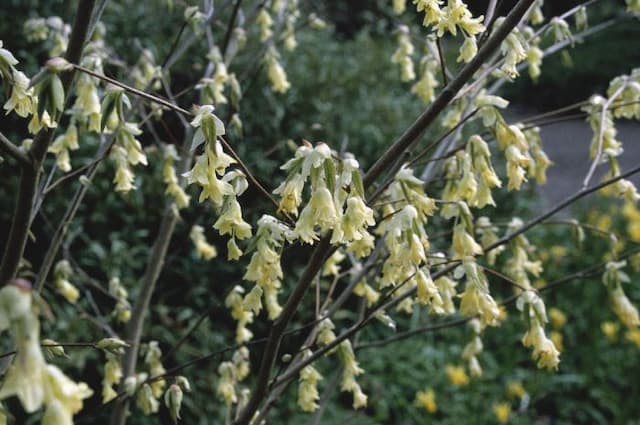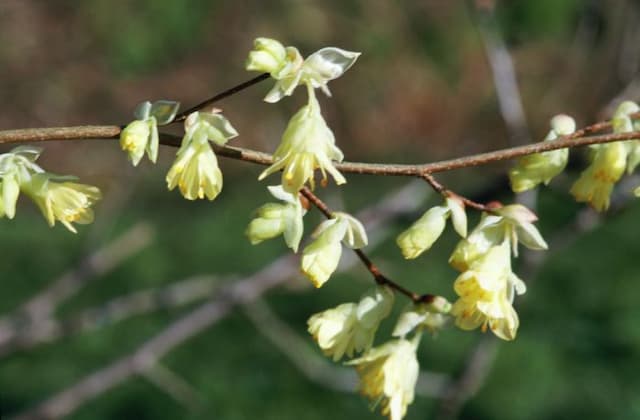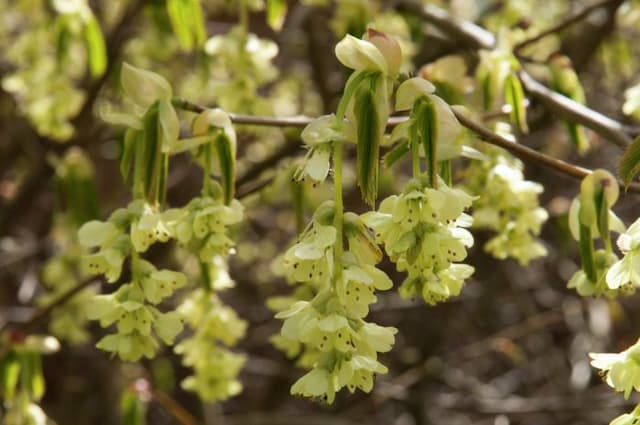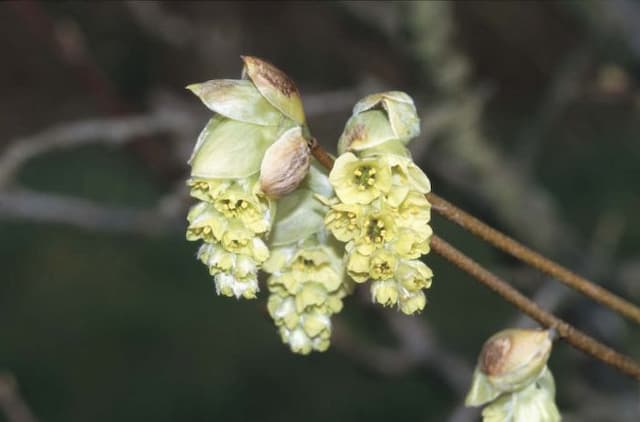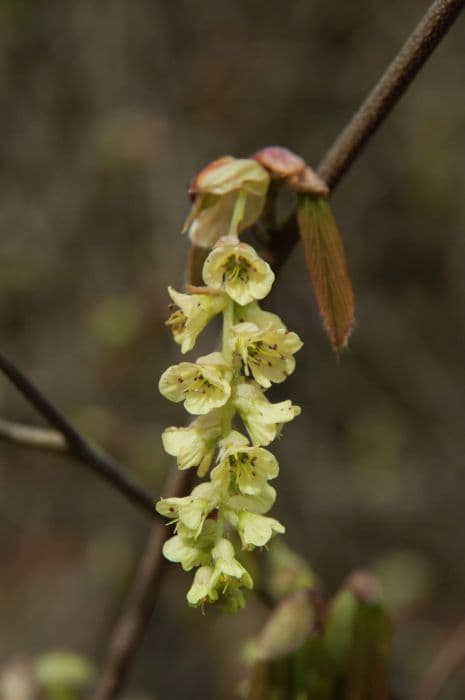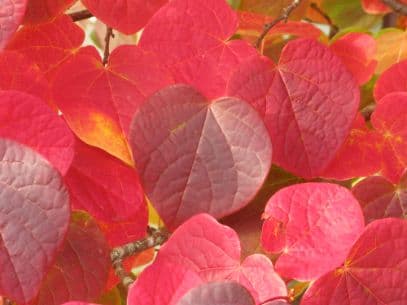Chinese Witch Hazel Hamamelis mollis 'Coombe Wood'

ABOUT
The plant known as 'Coombe Wood' is a type of witch hazel recognized for its distinctive appearance. This plant has large, broad leaves that are oval-shaped with wavy edges, often turning to a shade of yellow in the fall, giving it a warm seasonal presence. It is particularly noted for its striking flowers that bloom in the winter. These flowers are a vivid yellow with long, ribbon-like petals that are slightly crinkled, resembling thin strips of crepe paper. They exude a fragrant aroma that is often described as spicy-sweet, adding to the sensory appeal of the plant. The flowers emerge from clusters of buds along the branches, providing a burst of color during the cooler months when most other plants are dormant. Additionally, the branches of the witch hazel spread outwards, giving it a graceful, open shape that presents its flowers and foliage attractively. The bark of this plant is smooth with a light-to-medium gray color that contrasts nicely with its vibrant floral display. Overall, the 'Coombe Wood' cultivar is admired for its winter blossoms and pleasing foliage, offering both visual and fragrant delights in gardens and landscapes.
About this plant
 Names
NamesFamily
Hamamelidaceae
Synonyms
Chinese Witch Hazel
Common names
Hamamelis mollis 'Coombe Wood'
 Toxicity
ToxicityTo humans
Chinese witch hazel is not commonly known to be toxic to humans. There are no significant reports of poisoning or adverse effects from ingesting parts of this plant. However, it is generally advised not to consume any part of ornamental plants due to the potential for unexpected reactions or contaminants.
To pets
Chinese witch hazel is not commonly known to be toxic to pets. There is limited information available on the toxicity of this specific plant to animals, but there are no widespread reports of poisoning in pets from ingesting Chinese witch hazel. As with humans, it is wise to prevent pets from ingesting plants not intended for consumption to avoid any potential adverse effects.
 Characteristics
CharacteristicsLife cycle
Perennials
Foliage type
Deciduous
Color of leaves
Green
Flower color
Yellow
Height
12 feet (3.66 meters)
Spread
12 feet (3.66 meters)
Plant type
Shrub
Hardiness zones
5
Native area
China
Benefits
 General Benefits
General Benefits- Ornamental Value: Highly decorative with bright yellow flowers that bloom in winter when few other plants are in flower.
- Winter Interest: Provides color and texture to gardens during the colder months.
- Fragrance: The flowers emit a pleasant scent, adding a sensory dimension to the garden.
- Wildlife Attraction: Bees and other pollinators are drawn to the flowers, providing food sources during lean months.
- Drought Tolerance: Once established, it has good resistance to dry conditions, reducing the need for watering.
- Low Maintenance: Requires minimal pruning and care once it is established in the appropriate location.
- Seasonal Dynamics: Offers year-round interest with flowers in winter, fruit in late summer, and vibrant foliage in autumn.
 Medical Properties
Medical Properties- Astringent: The bark and leaves contain tannins and are sometimes used for their astringent properties.
- Anti-inflammatory: It may be used to soothe inflammation, especially in skin conditions such as eczema.
- Hemostatic: Witch hazel can help to stop minor bleeding when applied topically.
- Skin irritation: Used topically to relieve itching, irritation, and discomfort from insect bites or minor burns.
 Air-purifying Qualities
Air-purifying QualitiesThis plant is not specifically known for air purifying qualities.
 Other Uses
Other Uses- Photography: The vibrant yellow flowers of Witch Hazel 'Coombe Wood' can be used as an aesthetically pleasing subject in macro and botanical photography, especially during late winter when they are in full bloom.
- Artistic inspiration: Artists can draw inspiration from the twisted shapes of the branches and the bright flowers, using them as models for paintings, drawings, or even sculptural forms.
- Dye production: The tannins in the bark and leaves can potentially be used to produce natural dyes for textiles, offering shades ranging from yellow to orange.
- Floral arrangements: Branches of Witch Hazel 'Coombe Wood' can be cut and included in floral arrangements, adding unique texture and color to bouquets and indoor displays.
- Winter gardens: The plant can be used to add color and life to winter gardens, as it blooms during a season when most other plants are dormant.
- Privacy screening: When planted in a row, Witch Hazel 'Coombe Wood' can create a natural, aesthetically pleasing privacy screen that changes throughout the seasons.
- Garden structure: The strong, distinctive branching pattern of Witch Hazel can be used to add architectural structure to garden designs, even in the absence of leaves.
- Educational tool: This plant can serve as an educational tool in horticulture and botany classes, demonstrating the characteristics of winter-flowering shrubs.
- Fragrance enhancement: The flowers of Witch Hazel 'Coombe Wood' emit a pleasant scent that can naturally enhance the fragrance of a garden or outdoor space.
- Wildlife support: Witch Hazel can provide food for early-emerging pollinators that are searching for nectar sources at the end of winter.
Interesting Facts
 Feng Shui
Feng ShuiThe Witch Hazel is not used in Feng Shui practice.
 Zodiac Sign Compitability
Zodiac Sign CompitabilityThe Witch Hazel is not used in astrology practice.
 Plant Symbolism
Plant Symbolism- Healing – Hamamelis, commonly known as witch hazel, has long been known for its medicinal properties, particularly its ability to soothe skin irritations and wounds.
- Protection – Witch hazel is also associated with protection, possibly due to the strong, flexible nature of its wood, which was once used for dowsing rods believed to protect and locate underground water.
- Charm – The peculiar, spidery flowers of witch hazel bloom in winter, defying the cold and symbolizing an enchanting surprise or allure in the face of adversity.
- Resilience – Blooming in the depths of winter, witch hazel symbolizes resilience and the ability to endure harsh conditions with grace and beauty.
- New Beginnings – Since witch hazel is one of the first plants to flower in the year, it often represents new beginnings and the hope that comes with the start of a new cycle.
 Water
WaterThe Chinese witch hazel 'Coombe Wood' requires consistent moisture, especially during the growing season. Water the plant deeply once a week, providing enough water to moisten the soil to a depth of about 8 inches. In hotter, drier periods, you may need to water twice a week. Cut back on watering in the fall and winter when the plant is dormant. It's crucial to avoid overwatering; ensure the plant is in well-draining soil to prevent root rot. Typically, using about 1 to 1.5 gallons of water per week should suffice, adjusting for rainfall and temperature conditions.
 Light
LightChinese witch hazel 'Coombe Wood' thrives best in full sun to partial shade. It should be planted in a location that gets at least 4 to 6 hours of direct sunlight daily. However, in hotter climates, it benefits from some afternoon shade to protect it from the intense late-day sun.
 Temperature
TemperatureChinese witch hazel 'Coombe Wood' is hardy and can tolerate a range of temperatures. It has been known to withstand winter temperatures as low as 5°F and can survive summers up to 95°F, although it prefers cooler conditions. The ideal temperature for promoting good growth and flowering is between 30°F and 75°F.
 Pruning
PruningPrune Chinese witch hazel 'Coombe Wood' to maintain its shape and remove any dead or damaged wood. The best time for pruning is in the spring, shortly after the flowers have faded. Necessary pruning can be done every year, but extensive pruning should be done sparingly, preferably only every few years to maintain the natural form.
 Cleaning
CleaningAs needed
 Soil
SoilChinese witch hazel, or Hamamelis mollis 'Coombe Wood', thrives in well-draining, loamy soil enriched with organic matter, with an ideal pH range of 5.5 to 6.5. A mix containing equal parts garden soil, peat moss, and per-lite or sand is suitable for promoting healthy growth.
 Repotting
RepottingChinese witch hazel should be repotted infrequently, as it prefers to be slightly root-bound. Repotting is typically needed every 3 to 5 years, carefully avoiding excessive disturbance to the roots during the process.
 Humidity & Misting
Humidity & MistingChinese witch hazel prefers moderate to high humidity levels. Maintaining 40-60% humidity around the plant is ideal for its health and flowering, without the need for supplemental watering.
 Suitable locations
Suitable locationsIndoor
Place Chinese witch hazel in bright, indirect light; avoid dry air and drafts.
Outdoor
Plant in partial shade, shelter from strong winds, and mulch root zone.
Hardiness zone
5-8 USDA
 Life cycle
Life cycleThe life cycle of Hamamelis mollis 'Coombe Wood', commonly known as Chinese witch hazel, begins with seed germination in spring, following stratification which may take a full winter season as the seeds have dormancy mechanisms. Once germinated, the seedling grows into a small shrub, developing a root system and foliage over the spring and summer months. Over several years, the shrub matures into a large bush with distinctive broad oval leaves and begins its flowering stage in late winter to early spring, producing fragrant yellow flowers with long, ribbon-like petals before the leaves emerge. After pollination, typically by insects attracted to its scent and brightness in the sparse winter landscape, the plant sets seed in hard capsules that mature during the summer and autumn. The seeds are expelled from the capsules in the autumn and if not collected, may lie on the ground through winter until conditions are favorable for germination, thus continuing the cycle. Chinese witch hazel can live for many years, going through repeated cycles of flowering and seed production, generally reaching peak ornamental value within 10 to 20 years.
 Propogation
PropogationPropogation time
Late Winter to Spring
The most popular method of propagating Hamamelis mollis 'Coombe Wood', commonly known as Witch Hazel, is through softwood cuttings. This procedure is best conducted in late spring or early summer when new growth is still flexible. Cuttings should be about 4 to 6 inches (10 to 15 cm) long, with a few leaves left at the top. The cut end is dipped in rooting hormone to encourage root development and then planted in a mixture of peat and perlite or a well-draining potting medium. The cuttings should be kept in high humidity, with a plastic cover often used to maintain the moisture. It's important to provide indirect light and avoid direct sun exposure to prevent wilting. Roots generally develop within 4 to 8 weeks, after which the new plants can gradually acclimatize to normal conditions before being planted out.
